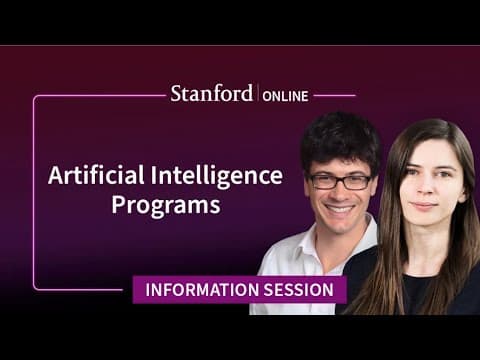Information Session: Artificial Intelligence Online Programs I August 2024
11 Sep 2024 (8 months ago)

Stanford Online AI Programs: Enrollment and Requirements
- The enrollment deadline for artificial intelligence classes in the fall is September 8th. (2m8s)
- The enrollment deadline for fall courses in the AI Graduate Certificate is September 8th, with courses commencing around September 24th. (59m59s)
AI Graduate Certificate Program
- The AI Graduate Certificate is modeled on the artificial intelligence specialization within the Computer Science Master’s degree. (6m17s)
- Students must take four courses to earn the AI Graduate Certificate, including at least one of the two core courses: Principles and Techniques of Artificial Intelligence and Machine Learning. (7m58s)
- Students can petition to have courses that are not explicitly part of the AI Graduate Certificate count towards an elective in the program. (9m21s)
- Students who have completed prerequisite courses for the AI Graduate Certificate can enroll directly in advanced electives. (57m36s)
- Students who wish to substitute a required course in the AI Graduate Certificate with an elective due to prior coursework must submit a separate petition to the department for approval. (57m52s)
- The AI Graduate Certificate program, students attend the same classes as on-campus students, earning a Stanford transcript, and requires 15-20 hours per week. (48m20s)
AI Professional Program
- The professional program, based on graduate-level courses, offers a manageable time commitment of 10-15 hours per week for each 10-week course. (29m58s)
- The AI Professional Program features pre-recorded lectures segmented by topic, accessible from the start of the course. (31m19s)
- The program consists of 10-week cohorts with approximately 160 learners, featuring a mix of written and programming assignments based on graduate-level courses. (32m55s)
- While faculty from Stanford, including Chris Manning, Chelsea Finn, and Emma Brunskill, support the program, course facilitators with industry experience provide direct support to learners. (32m39s)
- The AI Professional Certificate program offers flexibility with pre-recorded content, industry expert facilitators, and access to an online community. (49m20s)
Course Content and Structure
- The content of courses is constantly updated by faculty, so it is recommended to check the course pages for the most up-to-date information. (11m18s)
- Course content is available on YouTube and course pages, including example problem sets, past project work, and typical schedules. (53m21s)
- The courses CS229 and CS221, which are required for the Graduate portfolio, may require students to perform proofs and derivations. (36m57s)
- All assignments are written in Python, so familiarity with the language is strongly encouraged, although proficiency in other languages may be acceptable. (41m27s)
- Proficiency in Python and familiarity with other programming languages, calculus, linear algebra, and probability are recommended. (42m1s)
- Project work varies by course, with some courses offering individual or group options. A dedicated Slack channel is available for students enrolled in graduate programs to network and collaborate. (52m12s)
Program Staff
- PAX Heyer is the director of academic programs at Stanford Online. (10s)
- Petra Perova is the associate director of computer science and AI programs. (17s)
Program Access and Resources
- Students enrolled in online courses will have access to recorded lectures, live streamed lectures, assignments, and office hours via Zoom. (12m4s)
- Non-degree students who successfully complete courses with a B or better earn Stanford transcript credit that can be applied towards a master's degree if admitted. (13m36s)
- Students enrolled in single courses are not required to pursue a certificate program. (16m26s)
- Students pursuing a certificate can take courses outside of their certificate requirements. (16m38s)
- Students can apply up to 18 units earned as a non-degree student towards a master's degree at Stanford. (18m58s)
- Online courses do not provide a Stanford ID card, limiting access to campus buildings after hours. However, students can attend office hours as most academic buildings are open during the day. (26m29s)
- Students enrolled in online courses receive Stanford login credentials and email, granting access to online resources such as the library system and learning management system. Physical library access is not included but can be purchased. (26m44s)
Graduate Program Requirements
- Professional courses can be used to satisfy prerequisites for the graduate program, even though they do not earn credit. For example, the Machine Learning course can be taken as part of the professional program to fulfill the prerequisite for graduate-level courses. (20m52s)
- The graduate program requires a bachelor's degree with a minimum GPA of 3.0, although some classes may have higher requirements. Prerequisites include multivariable calculus, linear algebra, advanced probability theory, and extensive programming experience in Python, C, and Java. (21m41s)
- The application process involves submitting official transcripts, professional background information, a statement of purpose, and residency and personal information. GRE or TOEFL scores are not required. The statement of purpose should highlight relevant professional and educational experiences that demonstrate qualifications and readiness for the program. (22m33s)
- Students applying to the graduate program will need to demonstrate an academic background in math, such as an official transcript that includes grades from an accredited institution. (40m16s)
- Completing the professional course XCS 229 in machine learning satisfies the prerequisite for graduate courses requiring a machine learning background, such as CS224n (Natural Language Processing with Deep Learning). However, it does not count towards the graduate certificate. (55m48s)
Program Benefits and Applications
- Individuals working as data scientists, machine learning engineers, or company founders will find direct applications for the course material in their work. (43m4s)
- While no-code solutions for machine learning exist, a strong technical understanding of the underlying models is beneficial for debugging, developing solutions, and innovating. (44m1s)
- The Biomedical Data Science program combines artificial intelligence with medicine and involves programming and computation. (47m33s)